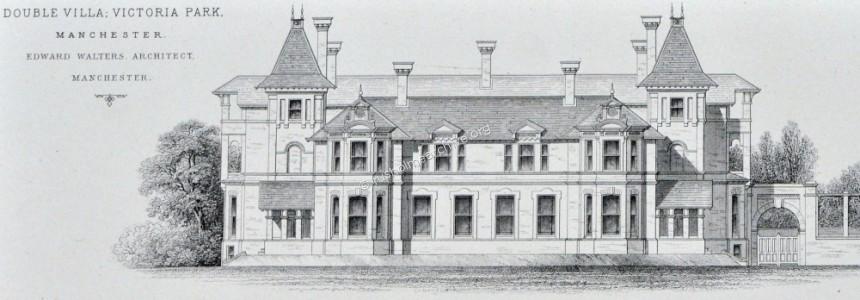Rusholme & Victoria Park Archive
The Peoples Institute, Nelson Street, Rusholme
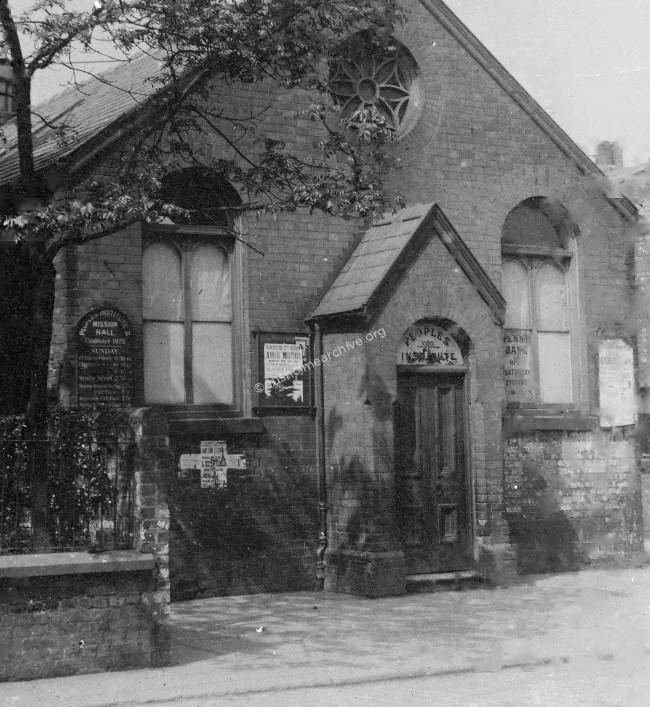
The Peoples Institute was established on Nelson Street in 1872 by members of different Christian faiths in Rusholme. The 'Peoples Institute' served as a Mission Hall for religious services, to provide educational and recreational facilities and where the first 'Boys Club' in Manchester was based.
In the photograph of the Hall is a notice in the window stating that the 'Penny Bank' was open on Saturday mornings.
In 1894 the committee of the Peoples Institute, Rusholme issued a report identifying Rusholme as an area of acute poverty. The opening paragraph is as follows;
'Rusholme is a name conveying very different ideas to different people. Situated on one of the most frequented roads out of Manchester, it is well known to all the residents on the south side of the city.
But what is known? The name is familiar. The old 'village' street is occupied for the most part with excellent shops, though a few older buildings testify to its evolution. Between the city and the 'village' lie Victoria Park and the district surrounding Whitworth Park and Moss Lane East. Beyond it has been a succession of fine houses. These surroundings have made people think of Rusholme as well-to-do suburb.
But there is a 'Back Rusholme', as well as the Rusholme that every traveller by bus or tram has known for years: and probably 'Back Rusholme' has been practically an unknown land to the vast majority of people passing along the main road. It is a compact district; but it is a compact district of congested poverty. It would not be too much to say that a bad Manchester slum has lain almost hidden behind the handsome shops on Wilmslow Road, and almost under the shadow of the big houses of the wealthy.
We want to emphasize the grave fact that here, close to a wealthy neighbourhood, there are back streets and courts, the houses of which violate all the conditions of healthy and decent living, and the inmates of which need all the ministry of help, in every form, just as much as in any of the slums in the city; and we here ask if it is not time, while making the Gospel of Christ our sheet anchor, to take note of the social and sanitary side of the question in regard to the district?
The photograph above shows the original hall, but in 1909 the hall was substantially rebuilt as a memorial to the Rev. McLaren, the well known local Baptist Minister who had been a leading member of the Institute. His wife had also played a significant part of this work and following is a note from a biography of Dr McLaren;
''In 1872, a mission was begun in "Rusholme," chiefly staffed and supported by the Union Chapel congregation. This was the nucleus of what is now known as the McLaren Memorial Hall.
At the beginning the very centre of the work (and it continues to this day) was the meeting for women held on the Monday afternoons. The name "Mothers' Meeting" was comparatively new in 1870, and it was with some doubt as to the desirability of bringing women away from their homes that it was begun, but it proved a success.
Photo below is courtesy of Manchester Libraries, Information and Archives, Manchester City Council
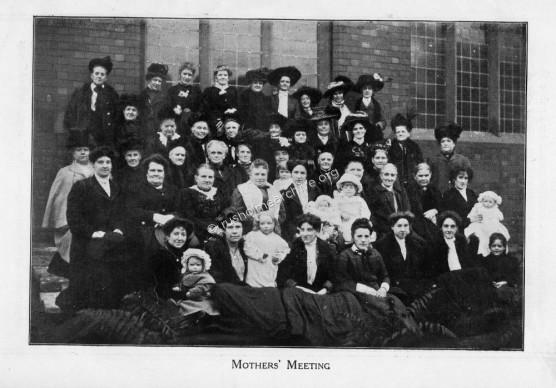
Mrs. McLaren took charge of the reading department and gave the Bible lesson at the end. She took much thought as to the selection of books to be read, and her husband's counsel was, that to be truly of use, to be remembered, they must be good all round (including the literary form), not merely well-intentioned as to motive.''
When the campaign started to raise money for the new building, William Royle who was Chairman of the Buildings Committee wrote to the Manchester Guardian and in his appeal for financial help from Guardian readers he made the following comments.
''There is urgent need in Rusholme for the proposed new 'Peoples Institute'. I have been connected with the present small building since its erection over 37 years ago.
During the whole of that time it has been a hive of social and religious Industry right in the midst of the working classes and has been of incalculable benefit to the poor of Rusholme.
We cannot begin building operations until we receive a further £500. Dr. McLaren has always taken a deep interest in the work of the " Peoples' Institute " and it would be a fitting close to his long connection with Manchester that this memorial to him should be successfully completed.''
The new hall was named the McLaren Memorial Peoples Institute and finally opened on December 10th 1910.A souvenir booklet was published, (price one shilling) and this contains a detailed history of the People’s Institute together with a number of interesting photographs. The Manchester Central Library has a copy of this booklet in their Archives and I should like to express my appreciation to the Library for allowing rusholmearchive.org to show this document in PDF format. Click on the link below to read the 1910 Souvenir Booklet.
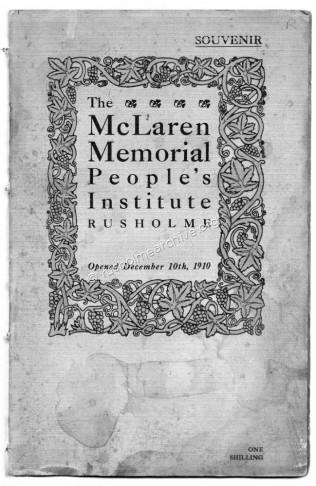
Courtesy of Manchester Libraries, Information and Archives, Manchester City Council
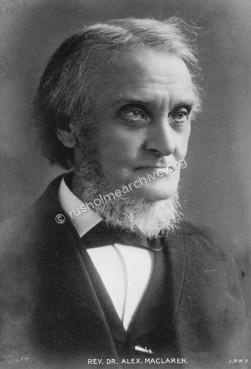
The Rev. Alexander McLaren, (1826 - 1910), was considered one of the most important preachers in the country. He served in Manchester at the Union Chapel, Oxford Road for a total of 45 years, from 1858 until 1903.
The photograph above of the Rev. McLaren was taken by Elliott & Fry, a London company founded in 1863 by Joseph John Elliott and Clarence Edmund Fry. The firm's core business was taking and publishing photographs of the Victorian public and social, artistic, scientific and political luminaries.
The photograph below is of Union Chapel, it was erected in 1869 and was sometimes referred to as the ''Nonconformist Cathedral of Lancashire''
The last service was in 1939, the chapel being purchased by Manchester Royal Infirmary so that the hospital could be enlarged. The war delayed these plans and the Chapel was finally demolished in 1950.
Three views below of the Union Chapel
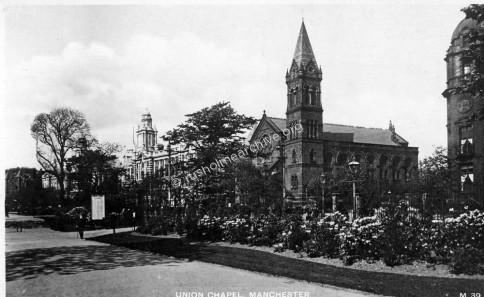
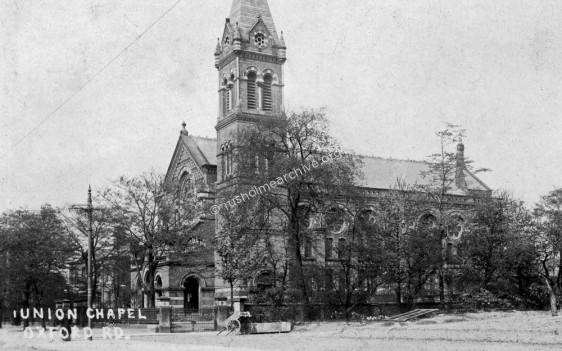
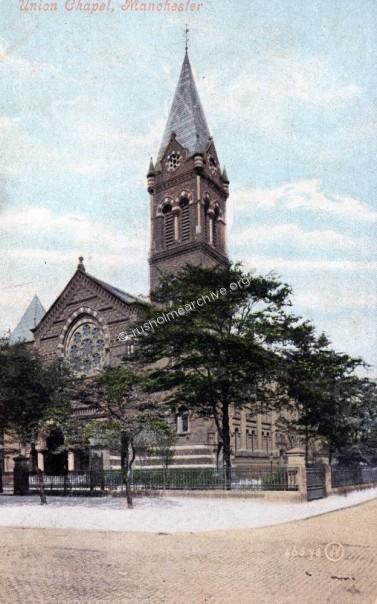
The Sunday and mid-week sermons by the Rev McLaren drew a packed and influential congregation including bankers, merchants, and manufacturers, MPs, writers, artists, students and fellow ministers, artisans, and clerks.
In 1896 the citizens of Manchester subscribed for a portrait of Maclaren to be painted by Sir George Reid FRSA and put in the City Art Gallery. At the presentation of the portrait in 1897 the Bishop of Manchester gave an address and said:
''In an age which has been charmed and inspired by the sermons of Newman and Robertson of Brighton, there were no published discourses which, for profundity of thought, logical arrangement, eloquence of appeal, and power over the human heart, exceeded in merit those of Dr Maclaren.Maclaren's preaching has been called “the supreme example, the perfect type, of the classic Protestant tradition of expository preaching.”
The newly built McLaren Hall in Nelson Street, Rusholme continued in use to until the mid 1960s and is now being used as a Mosque.
The photograph at the top of this page of the Peoples Institute was taken by a Rusholme photographer, Albert Meakes of Victoria Street. He was in business there from 1897 until 1913.
